Scalia Law School is Conservative!
The New York Times looks into ties between a DC area law school and the Supreme Court.
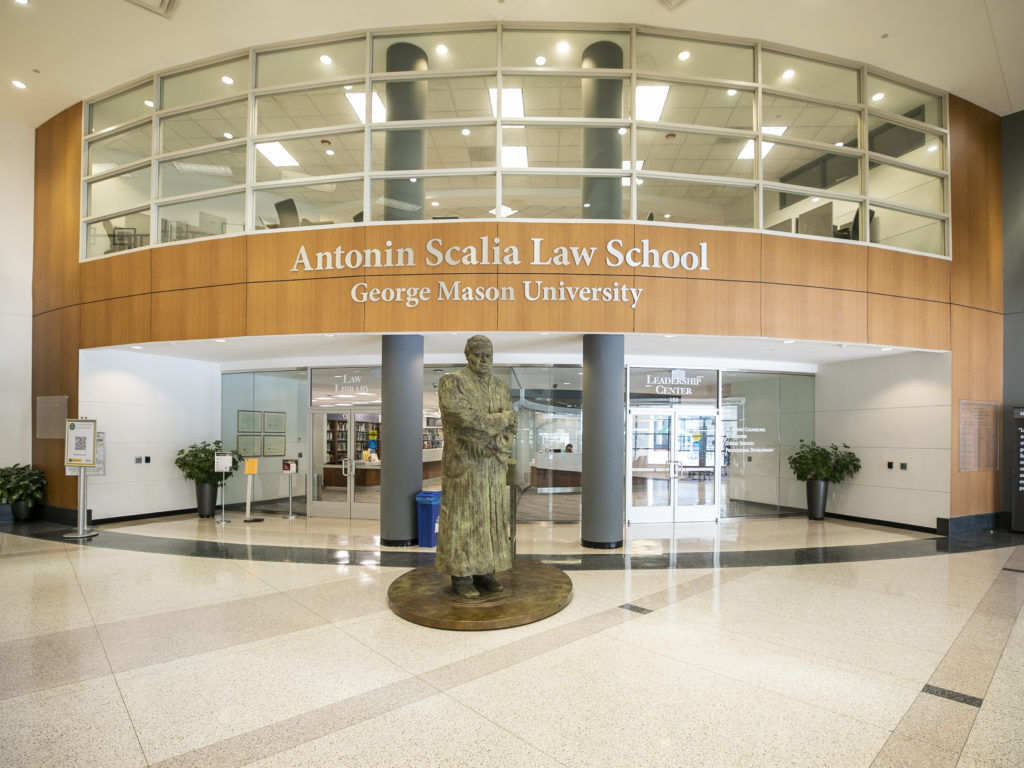
In yesterday’s NYT, investigative reporters Steve Eder and Jo Becker author a piece headlined “How Scalia Law School Became a Key Friend of the Court” with the ominous subhed “George Mason University’s law school cultivated ties to justices, with generous pay and unusual perks. In turn, it gained prestige, donations and influence.”
The lede:
In the fall of 2017, an administrator at George Mason University’s law school circulated a confidential memo about a prospective hire.
Just months earlier, Neil M. Gorsuch, a federal appeals court judge from Colorado, had won confirmation to the Supreme Court seat left vacant by the death of Antonin Scalia, the conservative icon for whom the school was named. For President Donald J. Trump, bringing Judge Gorsuch to Washington was the first step toward fulfilling a campaign promise to cement the high court unassailably on the right. For the leaders of the law school, bringing the new justice to teach at Scalia Law was a way to advance their own parallel ambition.
“Establishing and building a strong relationship with Justice Gorsuch during his first full term on the bench could be a game-changing opportunity for Scalia Law, as it looks to accelerate its already meteoric rise to the top rank of law schools in the United States,” read the memo, contained in one of thousands of internal university emails obtained by The New York Times.
By the winter of 2019, the law school faculty would include not just Justice Gorsuch but also two other members of the court, Justices Clarence Thomas and Brett M. Kavanaugh — all deployed as strategic assets in a campaign to make Scalia Law, a public school in the Virginia suburbs of Washington, a Yale or Harvard of conservative legal scholarship and influence.
George Mason is a public university whose main campus is just up the road from me. (The law school is on the Arlington campus, adjacent to DC, and maybe 45 minutes away from me.) My youngest stepdaughter is finishing her sophomore year there as I type and my late co-blogger Doug Mataconis was a graduate of its law school well before its 2016 rebranding as the Scalia School.
It stands to reason, then, that its internal communications are accessible to the public. But it’s hardly newsworthy that a law school in the national capitol region would want to enhance its prestige by attracting Supreme Court Justices to teach there. Nor, given that it chose the most stridently conservative justice in the modern history of the court as its namesake, is it shocking that it’s specifically cultivating ties with Republican-appointed Justices.
My druthers, frankly, would be that law schools—and institutions of higher learning more generally—strive to be intellectually diverse rather than identified with a particular ideology. But Mason’s business school and economics department long ago decided to become libertarian bastions, so that ship has already sailed to some degree. (I don’t get a sense that the larger university is particularly ideological. Or, rather, it’s a fairly typical university and its faculty tend to lean Democratic and, certainly, anti-MAGA.)
The law school had long stood out for its rightward leanings and ties to conservative benefactors. Its renaming after Justice Scalia in 2016 was the result of a $30 million gift brokered by Leonard Leo, prime architect of a grand project then gathering force to transform the federal judiciary and further the legal imperatives of the right. An ascendant law school at George Mason would be part of that plan.
Since the rebranding, the law school has developed an unusually expansive relationship with the justices of the high court — welcoming them as teachers but also as lecturers and special guests at school events. Scalia Law, in turn, has marketed that closeness with the justices as a unique draw to prospective students and donors.
Again, none of that is shocking or, indeed, unusual. It’s true that few law schools have an “expansive relationship with the justices of the high court,” let alone employ them as teachers or lecturers. In terms of both prestige and proximity, one would presume Georgetown or George Washington would be more likely to do so. But Mason is also very close to DC and has gone out of its way to be welcoming to conservative justices in a way that more traditional law schools have not.
Here’s where the piece seeks to become an exposé:
The Supreme Court assiduously seeks to keep its inner workings, and the justices’ lives, shielded from view, even as recent revelations and ethical questions have brought calls for greater transparency. Yet what emerges from the trove of documents is a glimpse behind the Supreme Court curtain, revealing one particular version of the favored treatment the justices often receive from those seeking to get closer to them.
The documents show how Scalia Law has offered the justices a safe space in a polarized Washington — an academic cocoon filled with friends and former clerks, where their legal views are celebrated, they are given top pay and treated to teaching trips abroad, and their personal needs are anticipated, from lunch orders to, in Justice Gorsuch’s case, house hunting.
By law, justices may earn outside income from a limited number of sources: book advances and royalties, investments, and teaching. The judicial code of conduct specifically encourages teaching. Many justices have augmented their government salaries, which now hover beneath $300,000, by holding classes at schools including Harvard, Duke and Notre Dame.
But Scalia Law quickly moved to the front of the line, in part by offering generous benefits. For teaching summer courses that generally ran for up to two weeks, Justices Gorsuch and Kavanaugh each made salaries that approached the legal cap on certain outside income, roughly $30,000 in recent years.
The school also creates bespoke programs for the justices in far-flung locations. Justice Gorsuch has traveled to Iceland and Italy to teach; Justice Kavanaugh has taught in Britain. During the first pandemic summer, both justices pressed on with their classes, teaching at stateside resorts. (Only Justice Thomas has routinely held his classes on campus, with two of his former clerks as co-professors.)
“When a justice is with us, we do everything we can to engage the justice with our students,” the law school’s dean, Ken Randall, said in a statement. He added, “Law schools serve students, and their education is undoubtedly enhanced by the justices teaching or visiting or speaking with students.”
Certainly, $30,000 for a two-week course is unusually high for contingent faculty, probably even in the law school. But the report provides no context as to what Justices typically earn from teaching—which, along with writing books, are something they’re actually encouraged to do by the judicial code of conduct. Travel to far-flung locales for these classes also raises eyebrows, although I suspect that it’s as much a boondoggle for regular faculty and administrators and a way to charge big bucks for summer courses as it is an inducement to the Justices.
At times, the justices’ teaching has intersected with their positions on the court.
Justices Gorsuch, Kavanaugh and Thomas regularly used employees in their chambers to coordinate their outside academic duties, despite a judicial advisory opinion — which the justices say they voluntarily follow — that staff members should not help “in performing activities for which extra compensation is to be received.”
And in a number of instances, the justices’ co-professors filed amicus briefs, trying to sway the court on pending cases, the records show.
So, I don’t love government employees coordinating their bosses’ outside employment. But the description is incredibly vague. If a Justice has a secretary or chief of staff who manages their schedule, it stands to reason that they have to factor in speeches (for which I gather they’re not allowed to make money) and teaching obligations. If they’re teaching regular courses, it’s a 10-minute outlay to block those dates and times off on the Justice’s calendar. It’s a little harder to coordinate availabilities for two-week junkets to Iceland.
Perhaps more problematic is amicus briefs from teaching colleagues. But, honestly, judges and Justices are going to have friends outside of work, most of whom are likely to be lawyers, judges, and legal scholars. I can’t imagine that Scalia Law is the only source of amicus briefs that creates this sort of conflict.
By any number of metrics, Scalia Law’s closeness to the justices has coincided with a striking upswing in its fund-raising and academic standing. The number of graduates receiving prestigious clerkships has steadily increased, and that has helped the school attract higher-caliber students. Scalia Law is now tied for 30th place in the U.S. News & World Report rankings, a big jump in a relatively short time. In the process, it has become something of a hub of conservative legal thought, and legal society, in the capital.
Scalia Law has hit its stride in part by capitalizing on the conservative outcry against “woke” elite institutions of higher education. Having a robust conservative alternative like Scalia Law “adds to the debate,” said C. Boyden Gray, a major donor to the school who held senior positions in both Bush administrations. “It is very healthy.”
Yet to a lesser degree, the school has also been able to entice the court’s liberals: Justice Elena Kagan, who has called for the court’s conservative and liberal wings to rediscover “common ground,” joined Justice Gorsuch as a distinguished guest when he taught his summer course in Iceland in 2021. Justice Sonia Sotomayor spoke on a Scalia Law panel with him the same year.
In late 2019, Justice Kagan emailed a George Mason professor who had clerked for Justice Thomas. “George Mason,” she wrote, “seems a really good place to be.”
Mason has found a niche and exploited it. As noted in the piece, it’s currently tied for 30th in the US News rankings—still well behind Georgetown (14th) and George Washington (tied for 25th) among DC area law schools but now ahead of American (73rd) and Catholic University (94th). Still, Mason is five spots below the University of Alabama, which has no such connections, in the rankings.
But, yes, they’ve schmoozed the Justices in a way that at least borders on unseemly:
Justice Gorsuch may have felt the same way when the law school, courting him in 2017, asked him to help choose the Italian city where, for two weeks the following summer, he would co-teach a seminar on national security and the separation of powers. A memo offered options including Padua, a “first-tier city in a picturesque setting,” Venice, with its “seven-mile-long-sandbar known as Lido” and Bologna, “Italy’s most prestigious academic city.”
In the end, the class would be in Padua, where the law school put up the justice and his family in what a listing described as an “aristocratic,” antique-filled apartment in the heart of the old town.
A draft handbook for the trip, emailed to Justice Gorsuch, made clear that his teaching responsibilities would be limited to the mornings, leaving plenty of time for excursions, including planned visits to Bologna and Florence.
“Fantastico!” the justice responded.
This is a pretty sweet deal. But, as noted muuuuuch later in the piece, not uncommon:
Other law schools have hosted justices on expenses-paid trips abroad. New York University, for example, sent Justices Ginsburg and Sotomayor to a conference in Portugal in 2019, though they did not receive teaching salaries. In 2016, Tulane paid Justice Alito to teach in Berlin and Paris, according to his disclosure from that year, and covered his expenses. Notre Dame, which counts Justice Amy Coney Barrett as a longtime faculty member, has recently been vying for the court’s attention, sending Justice Alito to Rome and Justice Kavanaugh to London.
Still, I agree with this assessment:
Amanda Frost, a law professor at the University of Virginia who specializes in legal ethics, said she found such arrangements troubling. “Some of this sounds like all-expenses-paid vacations, with a little teaching thrown in,” she said in an interview.
The rebranding as the Antonin Scalia Law School became official on July 1, 2016. Right away, the dean at the time, Henry Butler, began sending out save-the-dates for a dedication. At the top of his mind: ensuring that justices would be there.
The plan was for a day of celebrations in October, framed as a nonideological tribute to a justice beloved by his colleagues on both right and left. The renaming announcement quoted Justice Ruth Bader Ginsburg praising her close friend as “a law teacher, public servant, legal commentator and jurist nonpareil.”
But there was another aim, to raise money, with the justices as a draw. Justices Thomas and Ginsburg were to speak at a banquet in Washington’s historic Union Station. According to a seating chart, there would be tables named for the justices assigned to them: Justice Thomas (to be seated with Mr. Leo), Justice Samuel A. Alito (with former Vice President Dick Cheney) and Justice Ginsburg (with then-Judge Kavanaugh).
The Charles Koch Foundation was listed in the program as a $100,000 “platinum” sponsor, and the law firms Kirkland & Ellis and Gibson, Dunn & Crutcher were among those with $50,000 “gold” packages.
That mixing of the justices and the law school’s fund-raising brought a last-minute inquiry from the Supreme Court’s public information office. The court, according to an email to the dean from one of the school’s event planners, said it could not “clear the program” without confirmation that the dinner was “not a fund-raiser, because Supreme Court Justices cannot be involved in any fund-raising activities.”
Ultimately, Justices Thomas and Ginsburg did not speak, though both attended.
“Damn, this thing has be a lot of work,” the dean wrote to Mr. Leo, then the executive vice president of the Federalist Society, the conservative legal organization, and a co-chairman of the dinner. “But it is huge for Scalia Law (much bigger than the money.)”
So, rather clearly, the event was a fundraiser. But the fact that Ginsburg attended to honor her late friend would seem to be an indicator that the Justices, regardless of ideology, felt comfortable attending the event.
The law school, established at George Mason only in the late 1970s, had carved out a distinctive place on the right flank of legal academia. Its Law & Economics Center, devoted to one of the pillars of conservative legal thought — the idea that courts must consider the economic impact of the law — had offered training to more than 5,000 federal and state judges. Among the school’s most prominent alumni — indeed its only Supreme Court clerk — was William Consovoy, who had helped persuade the high court to strike down key provisions of the Voting Rights Act.
For all that, a year after Mr. Butler took over as dean in 2015, the law school’s U.S. News ranking dropped to 45th. “Falling out of the top 50,” administrators wrote, “would be a disaster from which the law school would have a very difficult time recovering.”
The rankings are notoriously volatile, particularly outside the elite tier. But, yes, they dropped five places that year.
By then, Mr. Butler had turned to Mr. Leo for help. He was a rising power in the conservative ecosphere, helping to steer money to advance the Federalist Society’s mission of filling the courts with judges who would interpret the Constitution according to the founders’ intentions. In September 2015, the dean sent Mr. Leo a five-year plan rooted in their shared belief that opportunity, and a deep well of donor money, lay in doubling down on the law school’s efforts to become an alternative to the left-leaning institutions that ruled the rankings.
Scalia Law, Mr. Leo wrote in response to questions from The Times, “is a model for what legal education should be in our country — grounded in objective analysis and truth-seeking, respect for the Constitution, and civility and balanced dialogue.”
The windfall, and the way forward, came quickly. About two weeks after Justice Scalia’s death on a Texas hunting trip in February 2016, Mr. Butler and Mr. Leo struck a $30 million deal with donors to rename the school for him.
Ten million dollars came from the Charles Koch Foundation; the balance, the school explained, came from an anonymous donor who had approached Mr. Leo. (The benefactor is widely believed to be Barre Seid, an electronics manufacturing mogul and conservative donor who would later make an extraordinary $1.6 billion contribution to a political group controlled by Mr. Leo.)
The announcement rewound an earlier controversy set off by revelations that gifts to George Mason from the Koch foundation had come with influence over hiring decisions. The foundation, in a statement, said it was deeply committed to “fostering an open exchange of ideas among a diversity of perspectives.”
The double deal was a master stroke.
The money would, among other things, allow the law school to support new research centers organized around areas of special concern for the legal right, including a Center for the Study of the Administrative State and a Liberty & Law Center.
Again, I’m not a fan of schools—let alone public universities—going all in on an ideology. It’s the opposite of what an institution of higher learning should be. But, having made that choice, Mason seems to have done it well: becoming the place (perhaps along with Notre Dame?) for conservative law professors by being not only ideologically welcoming but providing outstanding resources to support their scholarly endeavors.
The whole project of creating a cadre of ideologically-programed law students to serve as a feeder for the entire system is rather weird, if highly successful. But, thus far, only one student in the history of Scalia Law has gone on to clerk for the Supreme Court. Even the most conservative Justices continue to mainly draw from Harvard and Yale. So, thus far at least, Mason’s success here has been comparatively modest.
Then again, as noted in the report, it’s essentially a brand new school. Indeed, the university itself just celebrated its 50th anniversary last year and the law school is even younger. Harvard, by contrast, was founded in 1636 and its law school was founded in 1817.

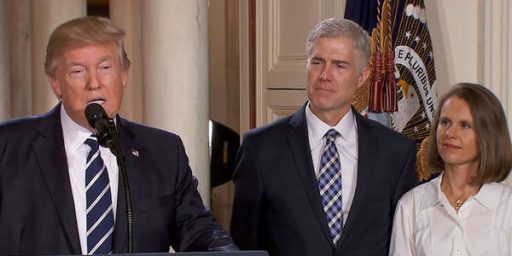
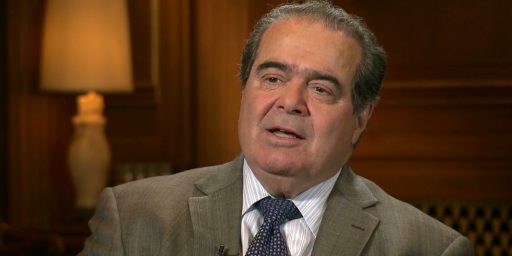
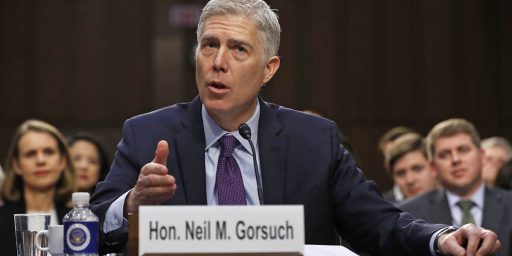
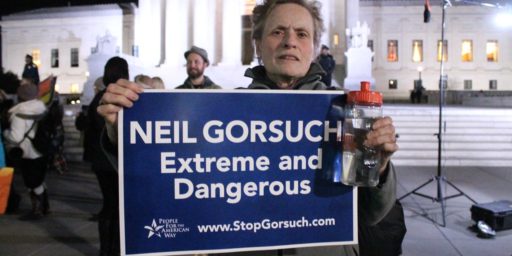
It’s perfectly normal for rich people to spend a lot of money influencing people with power. Nothing to see here. Move along.
Students in higher education should be taught to think for themselves in relation to the subject they’ve chosen. They should qualify to become independent professionals capable of weighing the evidence (not afraid to challenge established wisdom) and coming to informed conclusions.
While this, of course, is an ideal, it’s nonetheless an ideal that any school should strive for.
The “xxx party school” defeats that purpose and is a stain on any decent system of higher education.
@gVOR08: It seems to me that the primary goal here is to enhance the prestige of George Mason’s law school. There’s simply no evidence or reason to think that the Justices are going to rule differently on cases by virtue of getting the statutory maximum of $30,000 a year in fees for nominal teaching duties and a free two-week vacation to Italy. The endeavor began in 2016. There’s simply zero evidence that individual Justices are suddenly changing how they vote as a consequence and, indeed, it would be absurd to think that they would. The whole point of the Federalist Society conveyor built is to screen potential Justices starting in law school to weed out those who might “go rogue” well before they become nominees.
I recall reading Nietzsche a long time ago saying that laws are the rules made by the rich and powerful to ensure their wealth and position. I have not been able to find the source of that and would appreciate it if anyone could help my sagging memory. However, my experiences of life and the disclosures about the financial position of highly placed judges have always confirmed that idea. Talking about government by laws not men is beating an empty garbage can; makes a lot of noise, but it is just a garbage can. Laws are made to benefit the lawmaker.
Unless George Mason has a case before the SCOTUS this is unseemly, but not much more.
It certainly doesn’t rise to the level of corruption we are already aware of with these Justices.
And…right on cue–the Court is going to consider overturning Chevron.
Bottom line is you get what you pay for. Dreams of turning this country into an abattoir of corporate/Christian idiocy where some halfwit judges are going to get to the bottom of this here science are not popular. So you build an imitation of an elite space and populate with it dim lackeys and deferential abandon just to make them feel like they aren’t pieces of corrupt shit.
New reporting that Thomas ruled in favor of a Harlan Crow’s interests when he voted to end the federal tenant protections. The company, owned by Thomas’s benefactor, says the tenant protections threatened its real estate profit margins.
https://www.levernews.com/thomas-helped-kill-eviction-ban-threatening-benefactors-business/
James, you are (semi) burying the lede:
George Mason pays them exorbitant fees and sends them on all expenses paid vacations in return for associating the names of the Justices with their university. This is bribery. And while the stakes may seem to be small (on the order of paying the justices to do commercials for George Mason Law) I strongly, strongly suspect this is used as a method to give access to the Supremes for big George Mason donors, all without reporting. The fact that Ginsberg et al also engaged in behavior similar to this doesn’t mitigate it, but rather shows that such corruption creeps and grows and rots everything it touches
@gVOR08 & @James Joyner:
I want Equal Justice Under Law without money influencing judicial decisions, without haggling over how much is too much to pay a Justice before it‘s considered corrupt, without well-oiled “conveyor belts” feeding the system with the intent to get favorable opinions.
I also want a pony.
I wonder if the Scalia Law School will offer any sort of specialization in the civil law of seabird torts, given all the gull liability issues that have been coming up with SCOTUS lately.
@MarkedMan:
Oh, nonsense. The university is offering highly prominent individuals, limited to a very small cap on external earnings, a deal sweetener to choose their university over another. Bribery requires “the corrupt aim of influencing a public official in the discharge of his official duties.” There’s just no evidence that any Justice has changed a vote because of this.
@daryl and his brother darryl: I don’t like Justices being treated to lavish vacations by wealthy benefactors. But that was a 6-3 decision in which every single Republican-appointed Justice voted the same way and the three Democratic-appointed Justices dissented. Crow wasn’t a litigant in the case.
@James Joyner: “There’s just no evidence that any Justice has changed a vote because of this.”
No, but if the unspoken Federalist deal is “we’ll get you on the court and once you’re there we’ll make sure you get a never ending stream of cash and perks as long as you never go soft on us,” then isn’t that corruption as well?
Your tolerance of right-wingers being subsidized by billionaires to do their bidding on the excuse that they’re just toadies and lickspittles anyway so it doesn’t really make any difference looks worse and worse as American civil society is weakened every day.
@James Joyner:
I think this is right.
My guess is that they improved their screening process because many justices appeared to veer to the left during the course of sitting on the bench.
Of course the data that illustrates the various shifts is imperfect. But I suspect the perception is what matters.
@James Joyner:
That’s not how corruption works unless you’re already living in a failed state. Nobody reasonable thinks that Supreme Court justices are explicitly selling their votes for a $30,000 check. They’re not stupid enough to do that, and it’s not necessary to make an explicit exchange to get what their donors want. That’s one of the reasons the Court’s insistence that quid pro quo corruption is the only corruption that matters is so divorced from reality. But the fact that there’s no quid pro quo doesn’t mean there’s no corruption.
@James Joyner: James, I just think you couldn’t be more wrong on this. A corrupt network of special favors and private meetings is how entrenched power is maintained. The idea that there has to be a quiz pro quo with the exact details spelled out is just incredibly naive. The quid pro quo is their lifestyle and their position amongst their elite. If they stop playing they are ever so quietly ejected.
@wr: @Roger: @MarkedMan: The Ginni Thomas story is one of outright corruption. Most of the rest of the stories, though, strike me as much ado about little.
It appears that universities sending Justices on junkets in order to capitalize on their prestige is a longstanding practice. I don’t love it but don’t see a ton of real harm, either.
In an ideal world, I guess, Supreme Court Justices would be hermetically sealed, socializing only with one another, other judges, and their law clerks. That would insulate them from just about any conflict of interest. But, also, from the real world.
The Justices are elites by virtue of their power, small number, and life tenure. They’re much more important even than the billionaires who are financing these ventures. And, honestly, I think they’re buying association rather than influence. The Justices—liberal and conservative alike—are so vetted at this point that their vote on most issues is extremely predictable.
@James Joyner:
The vote count doesn’t change the fact that Thomas should have, in an ethical world, recused.
He was regularly accepting gifts from someone who had a clearly, and publicly, stated interest in the results of the case.
@Kurtz:
And having put them in the court, at great expense, they’re going to spend a little more doing what they can to keep them from deviating.
@James Joyner:
That’s the point. Crow, Koch, the 1.6 billion dollar guy whose name I can never remember, et al are pushing an ideology and loyalty to a class. It’s a giant, long-term version of the “meddlesome priest” thing. They all know the rules. They know how to signal the quid pro quo without stating the quid pro quo. Leonard Leo’s an asshole, he’s not stupid, and he knows the law.
@James Joyner: “The Justices—liberal and conservative alike—are so vetted at this point that their vote on most issues is extremely predictable.”
In that case, why not simply allow them to accept briefcases filled with cash? I mean, if their votes are based entirely on their “legal principles,” then they shouldn’t bend if Harlan Crow buys them an island, right?
@James Joyner:
I’m not certain about “most”. Something I’ve learned is that when an issue doesn’t have partisan valence, it becomes invisible. Nobody talks about it. I hear about it months or years after the fact. (Often, I wonder why it was that my news bubble never told me that.)